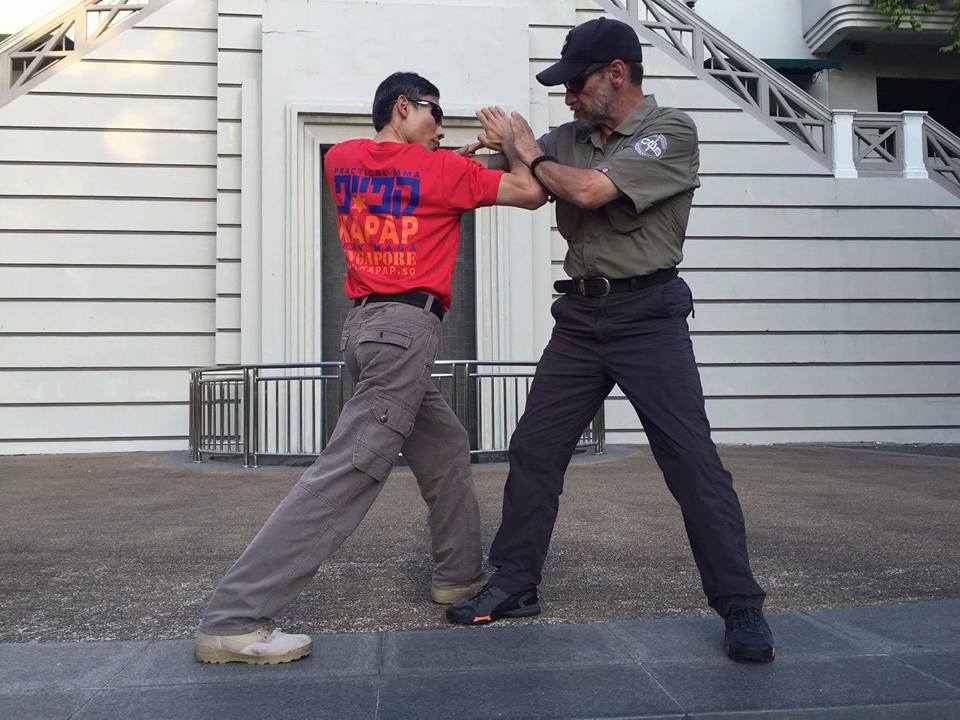The Significance of “Leaving Ego at the Door”
(SPANISH translation – below main text)
By Leon Koh
In the course of teaching martial arts and self defense, especially in these past few years, more particularly in the past few weeks, I have been contemplating the significance of a statement that have been uttered by many martial artists. One that has also adorned the walls of a many martial arts academies.
“Leave your ego at the door”.

This phrase has been used so much and cliché that it does not do justice to its significance. We often hear it on the lips of many trainers, reminding students of the need to “keep their ego in check”, “Leave your ego at the door”. It has become the mantra of many students and martial arts practitioners, yet the concrete actions they take to demonstrate it are elusive and varied. What does it actually mean to “leave ego at the door”, who does it apply to, and how can we actually approach this? Not just from a philosophical perspective, but a more practical and actionable stand-point.
Firstly, we must establish the definition of Ego. The term has been thrown around and loosely used. While ego and pride are synonymous, ego doesn’t just refer to one’s pride or sense of pride. Pride refers to one’s sense of self-respect and the importance of personal achievement. Ego, on the other hand, is that of one’s sense of self esteem and self importance. Ego also refers to one’s self concept. Therefore, having ego means to have an understanding of oneself and the value placed on one’s self-importance.
Considering these definitions, as a student, one must be able to suspend his perception of himself in order to progress and improve. To recognize that there are probably other selves that are not yet explored or developed. He should train to improve not to impress.

All too often we can see students trying too hard to impress, pretending to comprehend a subject. As a student, “leaving ego at the door” means having the awareness to know when to ask for help and when to accept help, with the purpose learning and thereby attaining mastery.
Oftentimes, leaving ego at the door is focused on the students of the martial arts class. This however should not be the case. It is equally applicable for the different roles that you play in the class, as a student and a training partner. As a training partner, he will need to leave his ego at the door and relegate his self importance. This will allow not only himself to improve, but also his training partners to progress.
For teachers, there is equal, if not more importance to manage their ego. It is, however, not so much as leaving ego at the door, but keeping it in check and adjusting it accordingly to the scenario. Many a great masters and teachers, some of whom I have the privilege and fortune of being mentored by, shows the depth on how “leaving ego at the door” can be actioned. Grandmaster Avi Nardia reminds us to be “Always a student and sometimes a teacher” and Mr Tony Blauer says it eloquently “Don’t show a student what you can do, show them what they can do”.
While students can be reminded by the teacher to keep their ego in check, under the watchful eye of their teachers, it is different for the teacher. In fact, just “leaving ego at the door” would be insufficient. Ego can be like a pet that wonders into your home, unless tied down with a leash. Teachers need to develop high self awareness and confidence, to metaphorically “tie-down” the ego at the door and not let it creep in while he is teaching. He would not see the need to impress the student in the class with showmanship and trickery, or to show students things which they are not yet ready for. Failure in doing so could mislead a student and affect their learning outcomes. Another aspect to consider is also the ability to acknowledge when an area is not of your expertise and have the willingness to learn, even from your students.
By actually understanding and managing one’s ego, we can harness to positively build character and to develop true subject and personal mastery. Perhaps it would be more appropriate to say “Adjust your Ego at the door and while on the floor”. Here are some actionable thoughts to help manage ego.
Practical Tips on leaving ego at the door for students
- Develop appropriate process oriented goals for training that do not have a performance component.
- Recognize and understand that every student comes to train for different reasons and with different backgrounds and varying competence and fitness conditions. Be empathetic, without judgement.
- Recognize and understand that training at different speeds present different training and learning benefits, as it engages different parts of the brain.
- Be open to feedback, genuinely seek feedback from peers and teachers.
- Only offer critique when solicited.
Practical Tips on leaving ego at the door for teachers
- Develop true competence in skill sets being taught, having it validated by peers, to have high level of Self Efficacy and therefore confidence.
- Focus on the learning outcome of the students
- Facilitate a mastery climate
- Planning for the desired behavioral outcome and responses.
- Understanding the goals of the student and only accepting the student when your teaching philosophy can bring about that desired outcome.
- Develop communication skills, as there is no learning disability, only teaching dis-ability.
- Constantly reflect on your actions and behaviour when conducting classes.

SPANISH:
En el transcurso de la enseñanza de artes marciales y defensa personal, especialmente en estos últimos años, más particularmente en las últimas semanas, he estado contemplando el significado de una declaración que muchos artistas marciales han pronunciado. Uno que también ha adornado las paredes de muchas academias de artes marciales. “Deja tu ego en la puerta”.
La frase se ha usado tanto que se ha convertido en un cliché que no le hace justicia a su significado. A menudo lo escuchamos en los labios de muchos entrenadores, recordando a los estudiantes la necesidad de “mantener su ego bajo control”, “Deje su ego en la puerta”. Se ha convertido en el mantra de muchos estudiantes y practicantes de artes marciales, pero las acciones concretas que toman para demostrarlo son esquivas y variadas. Entonces, ¿qué significa “dejar el ego en la puerta”, a quién se aplica? ¿Cómo podemos abordar esto, no solo desde una perspectiva filosófica, sino desde un punto de vista más práctico?
Primero tenemos que establecer la definición de Ego. El término ha sido utilizado libremente. Mientras que el orgullo y el ego son sinónimos. El orgullo se refiere al sentido de respeto propio y la importancia para el logro personal. El ego es el sentido de autoestima y la importancia personal,. no solo se refiere al orgullo o al sentimiento de orgullo. El ego puede ser visto como autoconcepto. Tener ego significa también tener una comprensión de ti mismo. El ego también podría referirse al valor asignado a la importancia personal.
Considerando estas definiciones, en el contexto de un estudiante, debe poder suspender su percepción de sí mismo para progresar y mejorar. Reconocer que probablemente hay otros yo que aún no se han explorado o desarrollado. Entrena para mejorar, no para impresionar.
Dejar Ego en la puerta es relegar su importancia personal para permitir, no solo, que usted mismo mejore, sino también nuestro compañero de entrenamiento, para así progresar. También podría significar tener la conciencia de saber cuándo pedir ayuda y también aceptarla. Con demasiada frecuencia podemos ver a los estudiantes tratando de impresionar demasiado, pretendiendo comprender un tema.
Muchas veces, dejar el ego en la puerta se centra en los estudiantes de la clase de artes marciales. Sin embargo, este no debería ser el caso. Es igualmente aplicable para los diferentes roles que desempeñas en la clase. Uno de los profesores, el asistente de enseñanza, el estudiante, el compañero de entrenamiento.
Desde la perspectiva de un entrenador, profesor, maestro, es igualmente importante suspender el ego. Muchos grandes maestros, algunos de los cuales tengo el privilegio y la fortuna de que me asesoren como el Gran Maestro Avi Nardia “Siempre un estudiante y, a veces, un maestro” y el Sr. Tony Blauer dice elocuentemente “No le muestres a un estudiante lo que puedes hacer , muéstreles lo que pueden hacer ”, cada uno enseña a su forma como esta máxima se puede aplicar.
La capacidad de dejar el ego en la puerta, también requiere que el maestro tenga suficiente auto conciencia, confianza en sí mismo, no hay necesidad de impresionar al alumno en la clase, mostrándoles cosas para las que aún no están preparados, ya que esto podría inducir a error ellos. Otro aspecto a considerar es también la capacidad de reconocer cuando un área no es de su experiencia, y tener la disposición de aprender incluso de sus estudiantes.
Aquí hay algunos pensamientos prácticos para ayudar a manejar el ego,
Consejos prácticos para dejar el ego en la puerta para los estudiantes.
Desarrollar objetivos orientados a procesos apropiados para la capacitación que no tienen un componente de desempeño
Reconozca y comprenda que cada estudiante viene a entrenar por diferentes razones y con diferentes antecedentes y diferentes habilidades y condiciones físicas.
Reconozca y comprenda que el entrenamiento a diferentes ritmos presenta distintos beneficios de capacitación y aprendizaje. Cada estudiante tiene su propio ritmo de aprendizaje
Esté abierto a la retroalimentación, busque genuinamente la retroalimentación de sus compañeros y maestros.
Solo ofrezca crítica cuando se solicite.
Consejos prácticos para dejar el ego en la puerta para profesores.
Desarrollar un nivel alto de competencia en los conjuntos de habilidades que se enseñan, validado por sus iguales, para tener un alto nivel de autoeficacia.
Centrarse en el resultado de aprendizaje de los estudiantes.
Planificación del resultado y respuesta conductuales deseados
Comprender los objetivos del alumno y aceptarlo solo, cuando tu filosofía de enseñanza puede lograr el resultado deseado.
Desarrolle habilidades de comunicación, ya que no existe una discapacidad de aprendizaje, solo una discapacidad de enseñanza.


